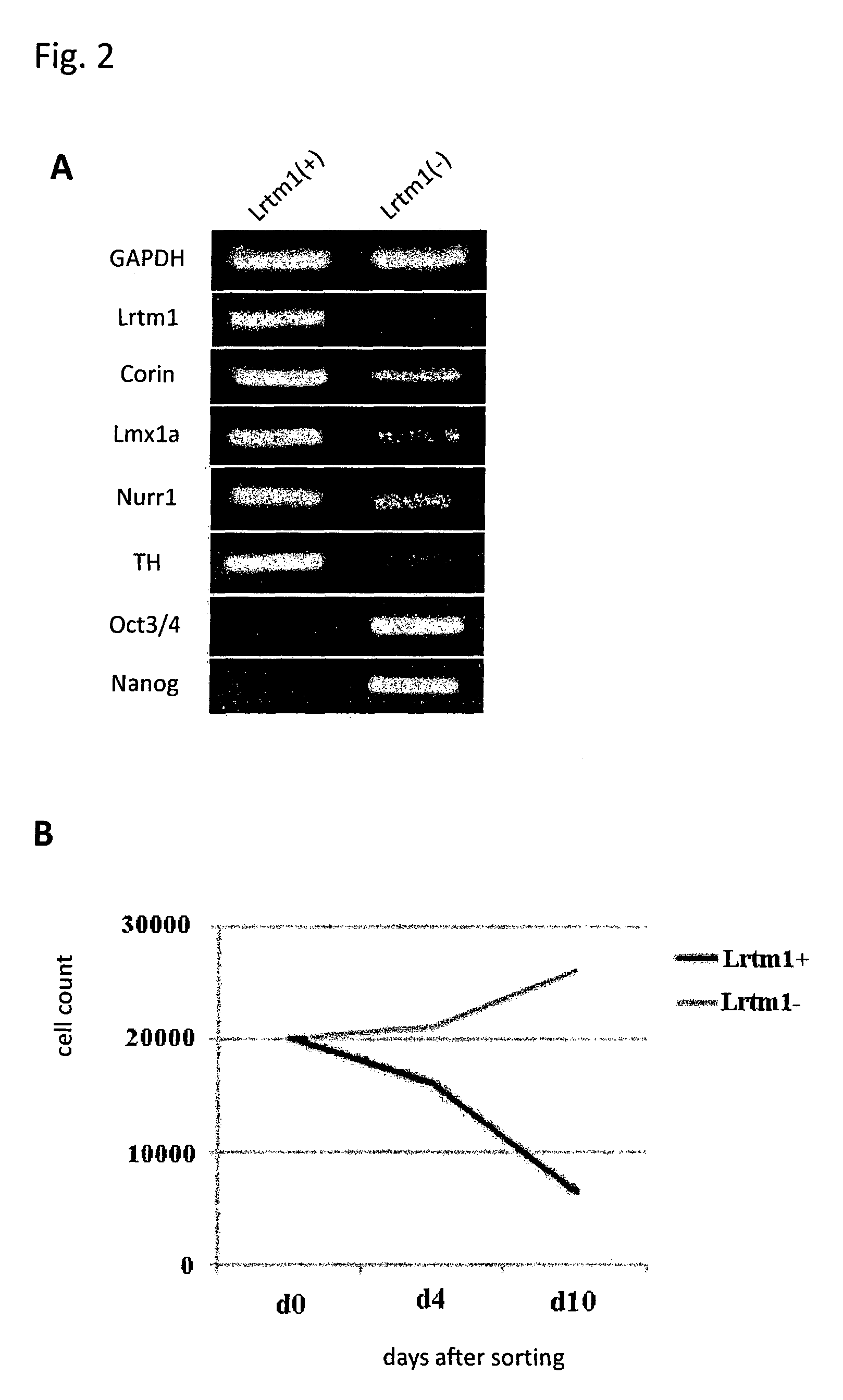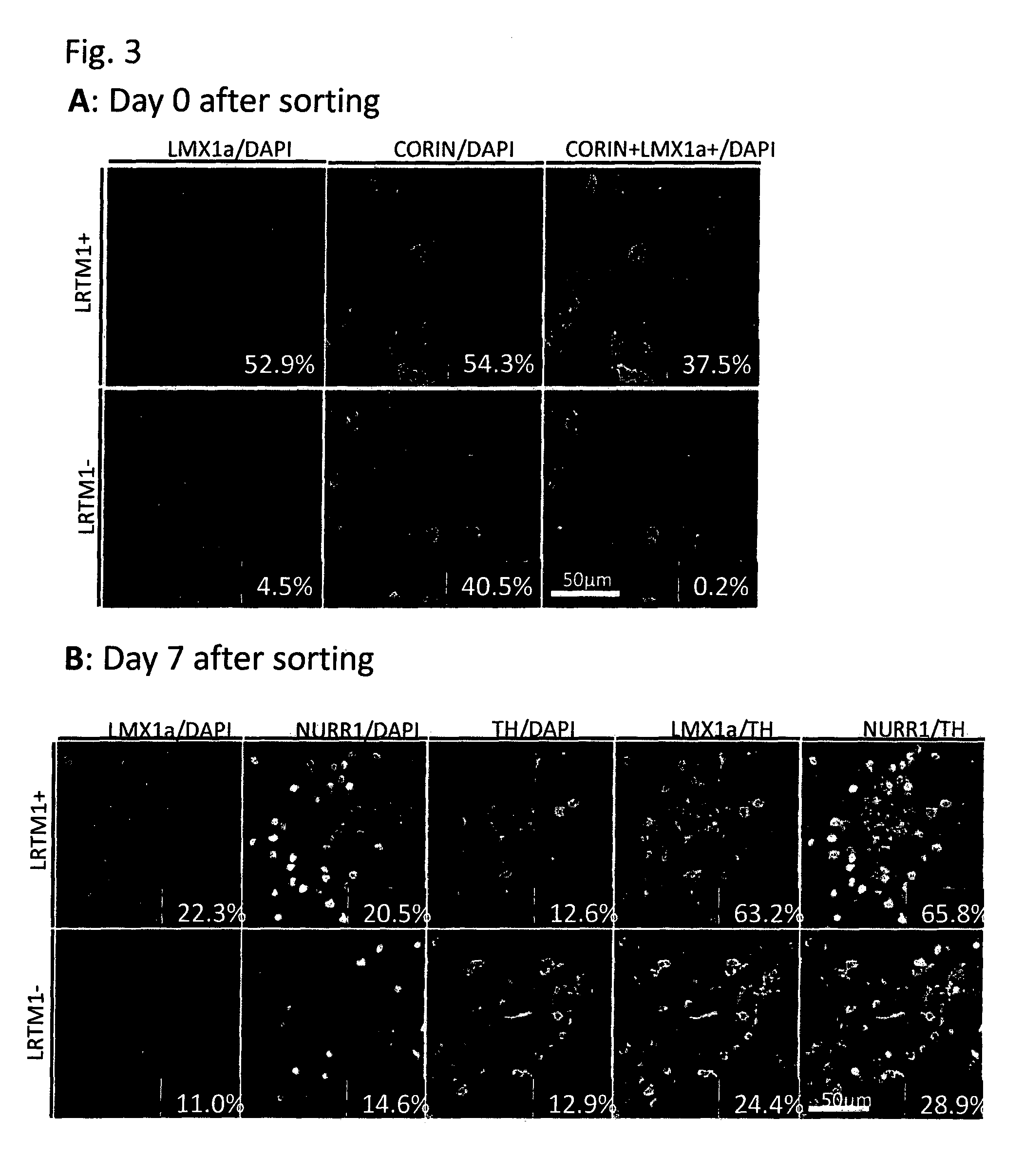Markers for dopaminergic neuron progenitor cells
a technology of dopaminergic neuron and progenitor cells, which is applied in the direction of instruments, drug compositions, skeletal/connective tissue cells, etc., can solve the problem of high risk of infection
- Summary
- Abstract
- Description
- Claims
- Application Information
AI Technical Summary
Benefits of technology
Problems solved by technology
Method used
Image
Examples
example 1
[0081]Human ES cells (KhES-1) were obtained from Institute for Frontier Medical Sciences, Kyoto University (Suemori H, et al. Biochem Biophys Res Commun. 345: 926-32, 2006). Human iPS cells (253G4) were obtained from Center for iPS Cell Research and Application, Kyoto University (Nakagawa M, et al. Nat. Biotechnol. 26:101-6, 2008).
[0082]The human ES cells and human iPS cells were induced to differentiate into neural cells by the SDIA (stromal cell-derived inducing activity) method described in Kawasaki H, et al., Neuron. 2000, 28:31-40 which was slightly modified. Briefly, the human ES cells or iPS cells were suspended in CTK (collagenase-trypsin-KSR) solution to form cell clumps (each comprising 10 to 20 cells), which were then plated on PA6 feeders in a 10-cm dish at a ratio of 1:2. The cells were cultured in GMEM (GIBCO) supplemented with 10 μM Y-27632 (ROCK inhibitor, WAKO), 2 μM dorsomorphin (BMP inhibitor, Sigma), 10 μM S13431542 (TGFβ / Activin / Nodal inhibitor, Sigma), 8% KSR, ...
example 2
[0086]Human ES cells (KhES-1) were obtained from Institute for Frontier Medical Sciences, Kyoto University. Human iPS cells (253G4) were obtained from Center for iPS Cell Research and Application, Kyoto University.
[0087]The human ES cells and human iPS cells were induced to differentiate into neural cells by the above-described SDIA method and the SFEBq (serum-free embryoid body quick) method described in Eiraku M, et al., Cell Stem Cell. 2008, 3:519-532 which were slightly modified. In the modified SFEBq method, the human ES cells or the human iPS cells were treated with Accumax (Innovate cell technologies) to be suspended into single cells, and then plated on a 96-well plate (Lipidure-coat U96w, Nunc) at 9,000 cells / 150 μL / well. The cells were cultured in GMEM supplemented with 10 Y-27632, 0.1 μM LDN193186 (BMP inhibitor, STEMGENT), 0.5 μM A-83-01 (TGFβ / Activin / Nodal inhibitor, WAKO), 8% KSR, 1 mM pyruvate, 0.1 mM NEAA and 0.1 mM 2-ME for 5 days. The medium was then replaced with ...
example 3
[0090]Mouse ES cells in which the GFP gene was knocked-in into the Lmx1a locus and GFP expression is regulated by the endogenous Lmx1a promoter were induced to differentiate into neural cells by the SFEB method. Briefly, the ES cells were suspended in GMEM supplemented with 2 mM L-Gln, 0.1 mM NEAA, 1 mM Sodium pyruvate, 0.1 mM 2-ME and 5% KSR, and subjected to suspension culture using a 96-well plate at a density of 3,000 cells / 150 μl / well. On Day 3 of the suspension culture, 100 ng / ml FGF8 was added to the medium. On the next day, 100 ng / ml SHH was added to the medium. On Day 7 of the suspension culture, the medium was replaced with GMEM supplemented with 100 ng / ml SHH, 20 ng / ml BDNF, 200 nM Ascorbic acid, 2 mM L-Gln, 0.1 mM NEAA, 1 mM Sodium pyruvate and 0.1 mM 2-ME. On Day 11 of the suspension culture, the cells were collected, and 4 fractions, that is, (1) GFP (Lmx1a)-positive and corin-positive; (2) GFP (Lmx1a)-positive and corin-negative; (3) GFP (Lmx1a)-negative and corin-pos...
PUM
| Property | Measurement | Unit |
|---|---|---|
| temperature | aaaaa | aaaaa |
| temperature | aaaaa | aaaaa |
| affinity | aaaaa | aaaaa |
Abstract
Description
Claims
Application Information
 Login to View More
Login to View More - R&D
- Intellectual Property
- Life Sciences
- Materials
- Tech Scout
- Unparalleled Data Quality
- Higher Quality Content
- 60% Fewer Hallucinations
Browse by: Latest US Patents, China's latest patents, Technical Efficacy Thesaurus, Application Domain, Technology Topic, Popular Technical Reports.
© 2025 PatSnap. All rights reserved.Legal|Privacy policy|Modern Slavery Act Transparency Statement|Sitemap|About US| Contact US: help@patsnap.com



